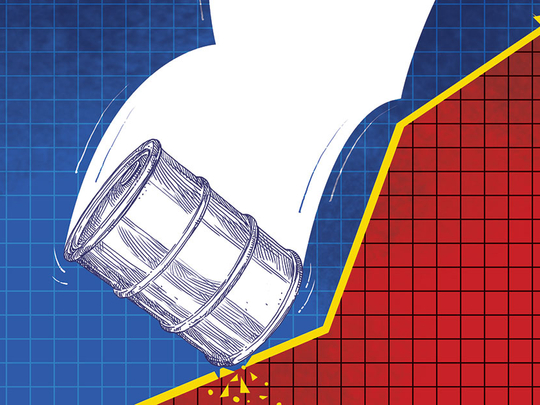
Sliding oil prices are something of a double- edged sword for investors. Cheaper energy is viewed very favourably on Wall Street because it amounts to a tax cut for consumers and so underpins stronger economic activity.
In turn, lower oil and commodity prices help contain inflationary pressures, anchoring interest rates at low levels and reducing the prospect of an imminent Federal Reserve tightening cycle.
Hence record highs for equities, with the S&P500’s rise for 2014 topping 10 per cent last week. While the S&P energy sector has been hammered by the 25 per cent drop in US oil prices since June, the broad equity market remains on course for its third straight year of double-digit gains.
A further slide in the price of oil, however, could challenge both equities and what has been a booming area of the junk bond market. At some point the benefits of cheaper energy may well yield to concerns over global growth and deflation. The current message from ebullient equities is that the US economy can remain insulated.
The trend of lower oil prices set a fresh milestone last week, as Brent oil futures prices fell below $80 a barrel for the first time in four years, down from a peak of$115 since June. Between 2010 and late 2012 there have been four distinct periods where a pull back in oil prices was accompanied by a correction in the equity market.
The relationship between oil and the S&P500, however, has broken down, with equities rebounding sharply in the wake of a near 10 per cent drop by mid-October, while the price of crude has continued falling.
At this juncture lower oil prices are not seen as reflecting weakening global demand, which would cast a lengthy shadow over the outlook for US companies that have large international operations. Indeed consumer stocks have picked up of late as investors rotate into areas that stand to gain from the prospect of greater retail spending.
“The equity market views lower oil prices as a positive supply-side shock, rather than a signal of weakening demand,” says Richard Gilhooly, strategist at TD Securities. However, he warns: “So long as oil prices are trying to find a bottom, there is a risk that equities will follow.”
Just like broad equities, we are also seeing a divergence within one of the riskiest areas of the bond market, and one that has registered enormous issuance of paper by the energy sector in recent years. The so-called “dash for trash” from investors clamouring for some kind of yield in a low interest rate environment has facilitated the US energy boom as lower-rated companies have found plenty of buyers for their debt.
Energy debt accounts for nearly 16 per cent of the US junk bond market, according to Barclays, a fourfold increase over the past decade. Energy has become the second-largest component of the high-yield market, raising the likelihood that many funds owned by retail investors are exposed to the sector.
Little wonder that the performance of lower-rated energy bonds has missed the recovery of the broad junk market. Energy bonds have registered a drop of 1.3 per cent while the overall junk market has climbed more than 1 per cent during the past month.
The lagging performance of the energy sector has not yet become a rout. Much depends on the behaviour of oil prices and whether we see stability.
Edward Marrinan, head of credit strategy at RBS Securities, says it is premature for investors to worry about energy bonds. “Oil falling towards $65 a barrel and staying there for a protracted period would become an issue for investors in the sector.”
Such a development would heighten pressure on highly indebted companies in the energy sector.
Ashish Shah, head of global credit at AllianceBernstein, says: “We will see credit issues in this space, but they should be relatively well contained.”
For now, investors are focusing on the silver lining of cheaper energy and downplaying larger macro risks. So long as oil stabilises, that approach works.
— Financial Times












